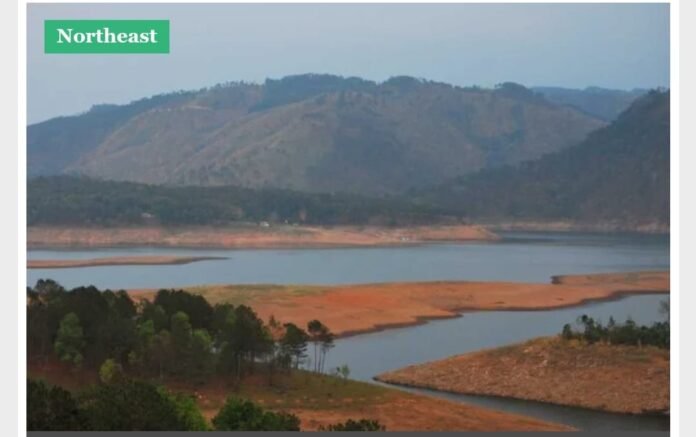Meghalaya’s Umiam water reservoir, popularly known as the Umiam Dam, is currently confronting a severe water crisis due to delayed monsoon rains. This critical situation poses significant challenges for one of the state’s most crucial hydroelectric power projects. With water levels reaching record lows, immediate attention and proactive measures are necessary to mitigate the potential impact on power generation and the surrounding ecosystem.
Declining Water Levels: The Umiam Dam, a vital infrastructure project in Meghalaya, is grappling with an alarming decline in water levels. The prolonged delay in monsoon rains has exacerbated the situation, resulting in critically low reservoir capacity. This dwindling water supply not only affects power generation but also raises concerns about irrigation, domestic consumption, and the sustenance of aquatic life.
Impact on Hydroelectric Power Generation: The Umiam Dam plays a pivotal role in meeting the electricity demands of Meghalaya and neighboring regions. However, the diminishing water levels have severely hampered its power generation capacity. With turbines operating at suboptimal levels, the state is experiencing a significant shortfall in electricity supply. This disruption affects daily life and poses a threat to industries and businesses relying on a consistent power supply.
Consequences for Agriculture and Livelihoods: Agriculture is a crucial sector in Meghalaya, where water availability is vital for crop cultivation and sustenance. The water scarcity caused by the declining levels at Umiam Dam can have severe repercussions on agricultural activities, affecting farmers’ livelihoods and exacerbating food security concerns. Additionally, the reduced water flow impacts the overall ecological balance, potentially endangering the flora and fauna dependent on the reservoir.
Mitigation Measures and Future Preparedness: Prompt action is necessary to address the worsening water crisis at Umiam Dam. Efficient water management strategies must be implemented, including optimizing water usage, promoting conservation practices, and exploring alternative sources to supplement the reservoir’s water supply. Rainwater harvesting initiatives and diversification of power sources can also help mitigate the impact of future monsoon delays.
Collaborative Efforts and Community Awareness: Dealing with such a critical issue requires a collaborative approach involving government agencies, local communities, and water resource management experts. Public awareness campaigns play a vital role in educating the community about the importance of water conservation and responsible usage. Engaging with farmers and providing support in adopting sustainable agricultural practices can contribute to mitigating the crisis.
Government Initiatives: The government must take swift action to address the water crisis at Umiam Dam. It should allocate resources to implement immediate relief measures such as water conservation projects, distribution of water-saving devices, and incentives for farmers adopting efficient irrigation techniques. The government should also invest in long-term solutions like the construction of additional reservoirs, exploring groundwater sources, and promoting renewable energy generation to reduce dependence on the dam.
International Support and Expert Assistance: Given the severity of the water crisis, seeking international support and expert assistance can be beneficial. Collaborating with organizations experienced in water resource management and dam restoration can provide valuable insights and technical expertise in tackling the challenges faced by Umiam Dam. International funding and technical assistance can help expedite the implementation of sustainable solutions.
The declining water levels at Umiam Dam present a significant challenge for Meghalaya, jeopardizing hydroelectric power generation, agricultural activities, and the overall ecosystem. Immediate action, including efficient water management, sustainable practices, and community involvement, is crucial. By taking proactive steps today, Meghalaya can better prepare for future uncertainties related to monsoon patterns, ensuring the long-term sustainability of the Umiam Dam and its associated benefits for the region’s development and well-being.



